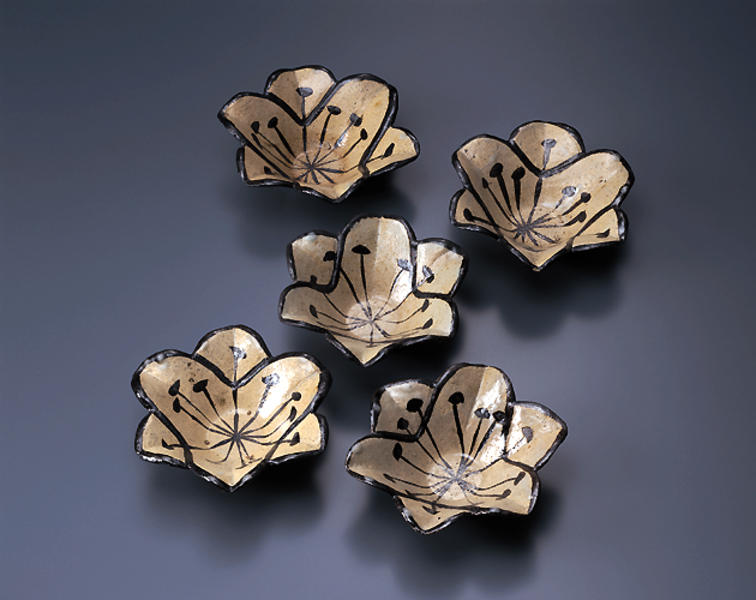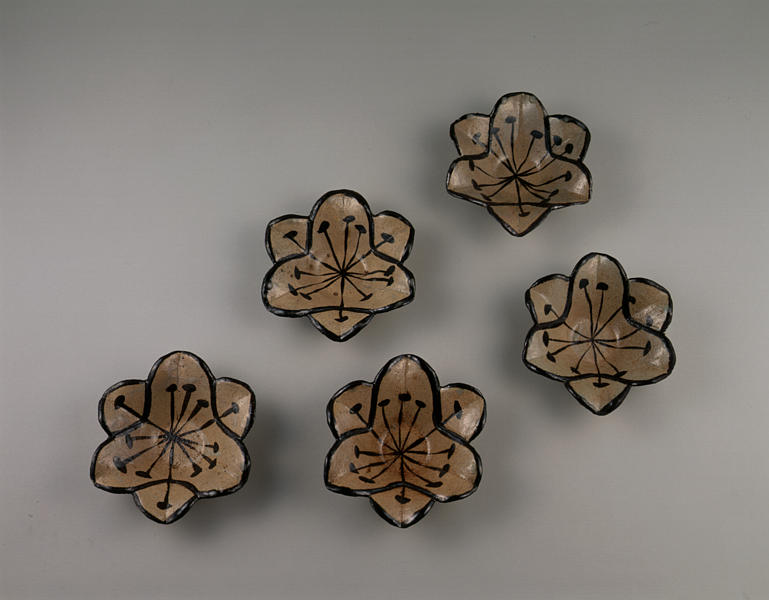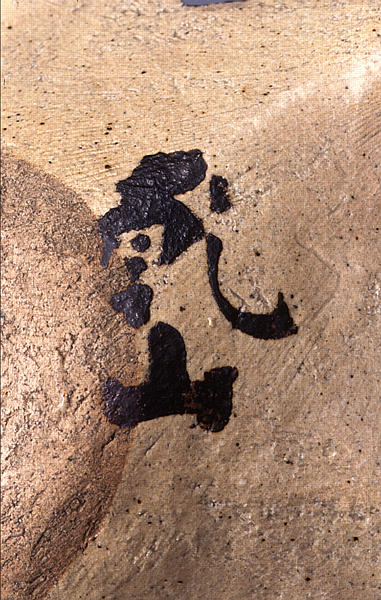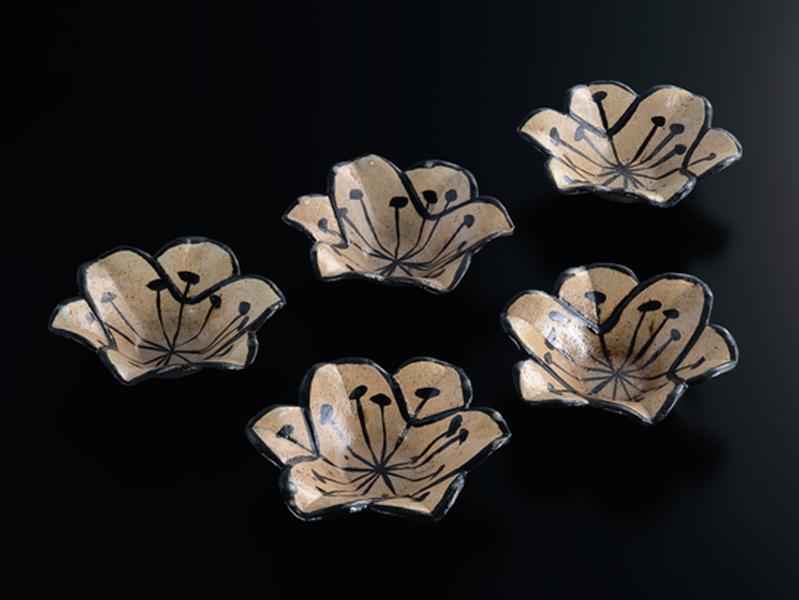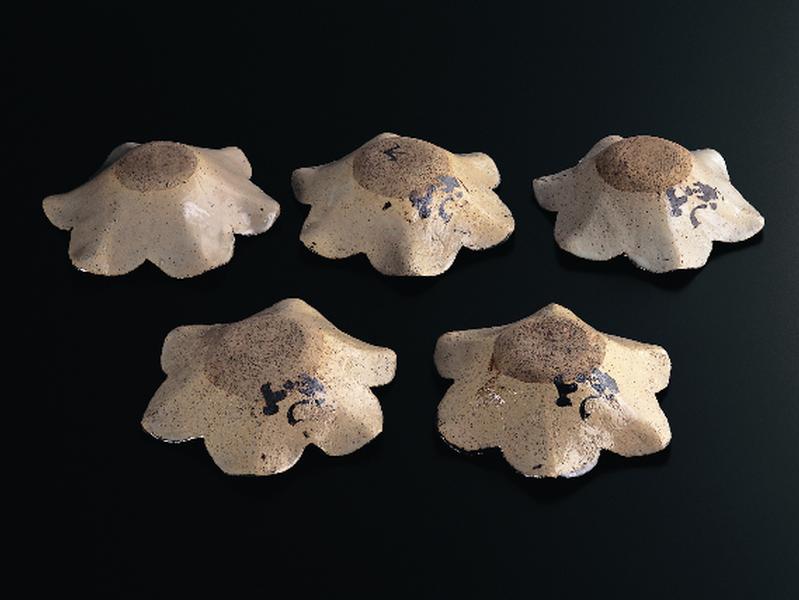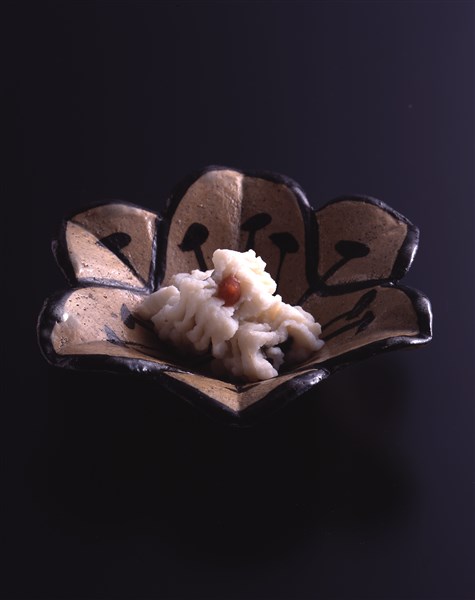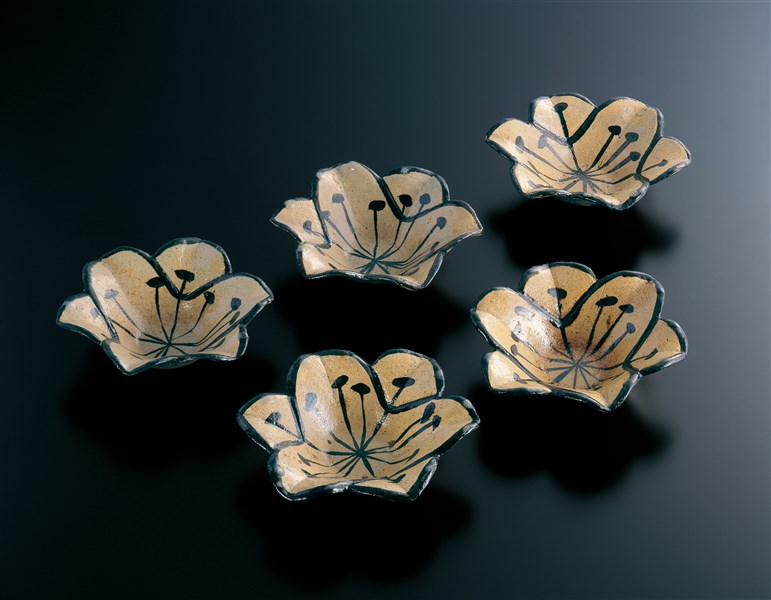乾山銹絵百合形向付
- 京都・鳴滝
- 江戸時代
- 18世紀
- 乾山陶製、鉄絵
- H-5.2 D-15.8
- 所蔵
- 益田鈍翁旧蔵
江戸時代 18世紀
高:5.2cm 口径:15.8cm 底径:5.8cm
型造りの向付で,器表面には型離れを容易にするためにあてられたと考えられる布の圧痕(布目)が残っている。銹絵で花弁の縁どりとしべが描かれ,全体に半透明の釉が掛
けられているが,外底部だけは露胎になっている。
乾山焼ではごく一般的な白泥を塗る手法も,この向付に関しては全く用いられていない。現在,京都の法蔵寺に所蔵されている鳴滝窯跡出土陶片のなかに,ほとんど同一の向付の口縁部破片が存在することから,この種の向付がすでに鳴滝時代には作られていたことが知られ,製作年代を考えるうえでの大きな手掛かりとなっている。
五客中四客に「乾山」の銹絵銘が施されているが,いずれも書体が極めてよく似通っており,同一人物の手によるものと推定される。銘は,くずしの少ない整った書体のもので,これは乾山焼の銘としては古相を示すものと考えられている。 (尾野)
尾形乾山
尾形乾山(おがたけんざん 1663~1743)
乾山は、寛文3年(1663)京都の富裕な呉服商尾形宗謙(おがたそうけん)の三男として生まれました。兄は画家の光琳です。二人の性格は対象的で、光琳が派手好みであったのに対し乾山は内省的、隠遁的な性格の持主であったといわれています。
野々村仁清に陶芸を学んだ乾山は、元禄12年(1699)37歳のとき京都市の鳴滝に開窯しました。そして正徳2年(1712)50歳の乾山は、京市内の二条丁子屋町に移住し、多くの作品を手がけ「乾山焼」として世にもてはやされました。鳴滝時代の末期からこの丁子屋町時代にかけて兄の光琳は絵付で乾山を助け、兄弟合作の作品が数多く残されています。
享保16年(1731)69歳の頃に江戸に下り寛永寺(かんえいじ)領入谷(いりや)に窯を築いて晩年を送りました。そして81歳で没するまで江戸に在住し陶器や絵画の制作に手腕を発揮しました。
乾山の作品は陶芸作品のみならず書や絵画においても、俗気を脱したおおらかで文人的な洒脱味があります。陶芸作品においては成形、施釉、焼成は他の専門的な陶工に任せたり、絵付についても光琳との合作以外に複数の専門画家が携わっていたと思われるなど、基本的には工房生産という態勢をとっていたようです。しかし、乾山の指導のもとにつくられたやきものには、その大胆なデザイン感覚とともに乾山特有の芸術性が溢れ、乾山その人とふれあうような親しみが感じられるのです。
乾山銹絵染付掻落絵替汁次
乾山銹絵染付梅波文蓋物
乾山立鶴図黒茶碗
乾山銹絵染付桔梗図筒向付
乾山銹絵染付草文四方鉢
乾山銹絵染付松図茶碗
乾山色絵短冊皿
乾山銹絵絵替長平皿
乾山色絵寿字輪花向付
乾山銹絵絵替四方皿
乾山銹絵染付絵替筒向付
乾山銹絵染付松図茶碗
乾山色絵椿文向付
乾山銹絵染付春草図茶碗
乾山銹絵染付藤図向付
乾山色絵立葵図向付
乾山色絵雪杉図向付
乾山色絵桔梗文盃台
乾山銹絵馬図香合
乾山銹絵染付絵替扇形向付
乾山銹絵掻落雲唐草文大鉢
乾山銹絵草花波文水指
乾山銹絵染付絵替土器皿
乾山色絵槍梅図茶碗
乾山黒楽梅図茶碗
乾山銹絵染付芙蓉図茶碗
銹絵掻落牡丹唐草文香合
撫子図(尾形乾山筆)
乾山色絵和歌陶板
乾山色絵竜田川図向付
乾山銹絵牡丹画角皿 尾形光琳画
乾山銹絵松文香合
乾山色絵阿蘭陀写市松文猪口
乾山色絵薄図蓋茶碗
乾山銹絵菊図水指
鶴亀図黒茶碗
紅葉図 尾形乾山筆
三十六歌仙絵/在原業平像 尾形乾山筆
三十六歌仙絵/斎宮女御像 尾形乾山筆
乾山色絵菊文手付汁次
三十六歌仙絵/小野小町像 尾形乾山筆
乾山銹絵染付山水図茶碗
Catalogue Entry
Set of 5 dishes
Edo period, 18th century
Kenzan ware, underglaze iron decoration
Height, 5.2cm; mouth diameter, 15.8cm;
base diameter, 5.8cm
These mold-cast mukozuke dishes still show traces of cloth impressions on the exterior surface of the dishes which is thought to indicate where cloths were used to allow ease of removal from their molds. Underglaze iron has been used to outline the flower petals and to indicate their stamens and pistils. A transparent glaze has been applied all over, except for the foot exterior which has been left unglazed.
The extremely common Kenzan ware method of white-slip application was completely avoided on these dishes. Among the shards excavated at the Narutaki kiln site and now in the collection of Hozoji, Kyoto, there is a shard of the mouth rim of a mukozuke dish of almost exactly the same shape. This indicates that this shape of dish was being created as early as the Narutaki kiln period, and this shard provides an important clue to the dating of these dishes.
4 of the 5 dishes are inscribed "Kenzan" in underglaze iron, and as all of these inscriptions are in almost exactly the same calligraphy style, it can be suggested that the inscriptions were all brushed by the same hand. The inscription is in the regular form with very little abbreviation, and this is thought to indicate the older form of Kenzan ware inscriptions. YO
銹絵百合形向付 五客 乾山
銹絵百合形向付 五客 乾山 図録解説
百合の花をそのままかたどった手法は仁清(東京・根津美術館、京都・野村美術館蔵)にも見られます。
ざっくりとした土を使った絵唐津風の焼き成り、花弁の重なりに段差を設けて立体感を出した上に、銹絵(鉄絵に同じ。茶色や黒褐色に発色する鉄釉で絵付けしたもの)で花弁を縁取って蘂(しべ)を描いた仕上がりの乾山の百合形向付は、存在感と力強さを感じさせます。器表面には型から離れやすくするためにあてられた布目跡が残っています。五客中四客に記されている乾山銘はよく似通う整った書体で、明らかに文字性を留めています。
鳴滝窯跡出土遺物の中にこの向付の部分と一致する陶片がいくつかあり、草創期の近代日本をつくりあげ、また大茶人でもあった益田鈍翁のお眼鏡にもかなった乾山窯鳴滝時代を代表する作品といっていい向付です。
Lily-shaped Mukozuke Dishes (Set of 5)
Lily-shaped Mukozuke Dishes (Set of 5)
Formerly in the collection of Masuda Don'o
Forming pieces in the shape of lily flowers is a method that can also be seen in Ninsei's work (Nezu Museum, Tokyo; Nomura Art Museum, Kyoto).
The effect is similar to E-Garatsu ceramics in its use of a rather coarse clay. The overlapping petals give the work a three-dimensional feel. Kenzan has finished these mukozuke by using underglaze iron, which produces brown or blackish-brown hues, to outline the petals and add the stamens. (Decoration in underglaze iron is known as sabi-e.) The result is a powerful presence. The surface of these pieces has traces of the texture applied to make it easier to remove them from the mold. The Kenzan signatures on four of the five pieces are written in a very similar, clean style that clearly indicates mindfulness of their calligraphic nature.
Several shards that correspond to these mukozuke have been discovered among the artifacts from the Narutaki kiln site. These works, which measured up to Masuda Don'o's standards, exemplify Kenzan's Narutaki period.
